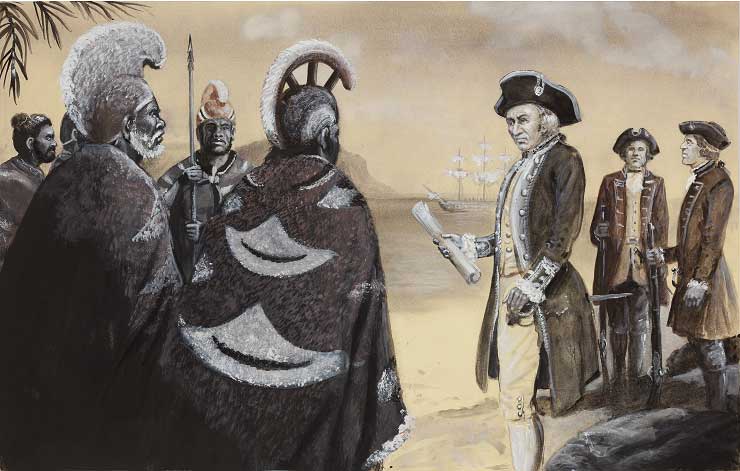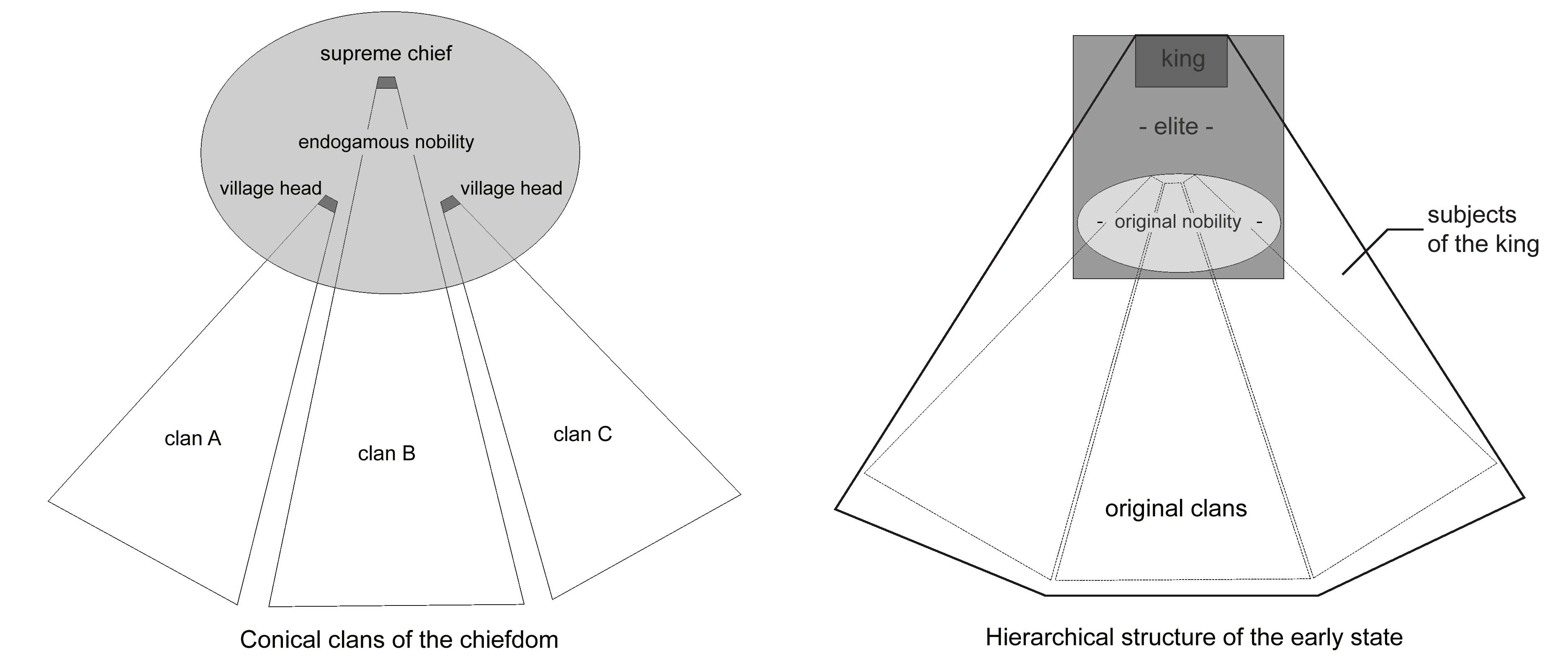Another means of identifying the boundaries between modern and traditional societies was the categorisation of the differences between the manner of their social organisation and their driving mechanism. Based on the multi-criteria approach the American Elman Service was the first anthropologist to define the division of society into four groups, while his typology also reflected its evolutionary aspect. Division into bands, tribes, chieftain units and states is still in current use today, though not without certain reservations. Critics point in particular to the problems that are associated with attempts to apply a typology that was created in relation to recent pre-industrial populations to societies that are identified only in historical or archaeological sources.
|
|
|
Captain James Cook meeting with several Hawaiian chieftains. An attribute of their high position was their rare mantles covered with parrot feathers and their caps decorated in the same manner. Illustration by Petr Modlitba. |
Smaller groups of hunter-gatherers are referred to as bands. In general their members were related either by blood or by marriage. The bands lacked any formal chieftains, nor were there any striking differences in regard to the ownership of property or of social status between the members. The fact that the bands were both quite small and mobile was also reflected in the size and the structure of their settlements. Modern examples of bands of this nature are the Bushmen of southern Africa and the Hadza in Tanzania.
According to Elman Service, generally the tribes were more significant than the bands, but only rarely did the number of their members attain several thousand people. Their diet usually comprised domestic resources. They were both sedentarised farmers and migrant herders. The tribe comprised a collection of individual communities (families, villages, etc.) that were mutually linked by family ties, either real or declared (i.e. claimed). Tribes usually lacked both official representatives and a “Capital City” because there was no need for an economic base in order to create power structures. The settlements took the form of homesteads or of villages. According to Service this grouping was supposed to represent some sort of transitional form, somewhere between a band and a chiefdom.
As social organisations chiefdoms were made up of several branches of various kinship groups or conical clans. Their members were internally differentiated in them on the basis of their kinship with a real or a mythological ancestor who was viewed as being the founder. The political representative of a society of this nature was a chieftain who inherited his position from within a specific defined circle of relatives. Prestige and status in the society were derived from how close the relationship between the individual and the chieftain was. This was also reflected in the funeral rites. The centralisation of power was manifested primarily in the area of spiritual ceremonies and rituals. The authority of the chieftain largely coincided with his priestly functions. Another feature therefore was also the existence of a permanent sacred place. It must be admitted that there could be a large number of chieftain systems with different mechanisms of functioning that could co-exist. Historical traces of this can be found on the northwest coast of North America, for example.
The last category is that of the early states. They gave rise to a complexity that characterises the more intricate social formations. Though the early states retained a number of the features of the chieftain groups, unlike them these were societies of a non-relational type (i.e. status was acquired based on qualities, not on origin) stratified into different social classes. This gave rise to an elite that included officials, soldiers and priests. The top level of this imaginary pyramid was occupied by the King. He had explicitly been given the power to implement laws and to enforce them, even by violent means. The institution of donation also ended in the early states and was replaced by the levying of taxes.
Usually the early states were small in terms of the size of their territory, often consisting of a single dominant city together with its economic hinterland. Because the state-building process was also regionally contagious, so to speak, several states coexisted in the area more or less on a regular basis. Inevitably, together, they formed an interactive network that dynamically transformed its goals from peacekeeping to war. The King had become the King of Kings by conquering the neighbouring rulers and inevitably his empires ceased to meet the requisite criteria for being an early state.
|
|
|
A schematic representation of the conical clans of the chieftain society and of the heterarchical structure of the early state. |
Want to learn more?
- Earle, T. K. 1991. Chiefdoms: power, economy and ideology. Cambridge and New York: Cambridge University Press.
- Morgan, L. H. 1877. Ancient Society. Or Researches in the Lines of Human Progress from Savagery through Barbarism to Civilization. London: MacMillan & Company.
- Parkinson, W. A. (ed). 2002. The Archaeology of Tribal Societies. Michigan: Ann Arbor.
- Service, E. R. 1962. Primitive Social Organization. An Evolutionary Perspective. New York: Random House.
- Service, E. R. 1975. Origins of the state and civilization: the process of cultural evolution. 1st ed. New York: Norton.
- Yoffee, N. 2005. Myths of the archaic state: evolution of the earliest cities, states and civilizations. Cambridge and New York: Cambridge University Press.
 Archeologické 3D virtuální muzeum
Archeologické 3D virtuální muzeum

.jpg)

